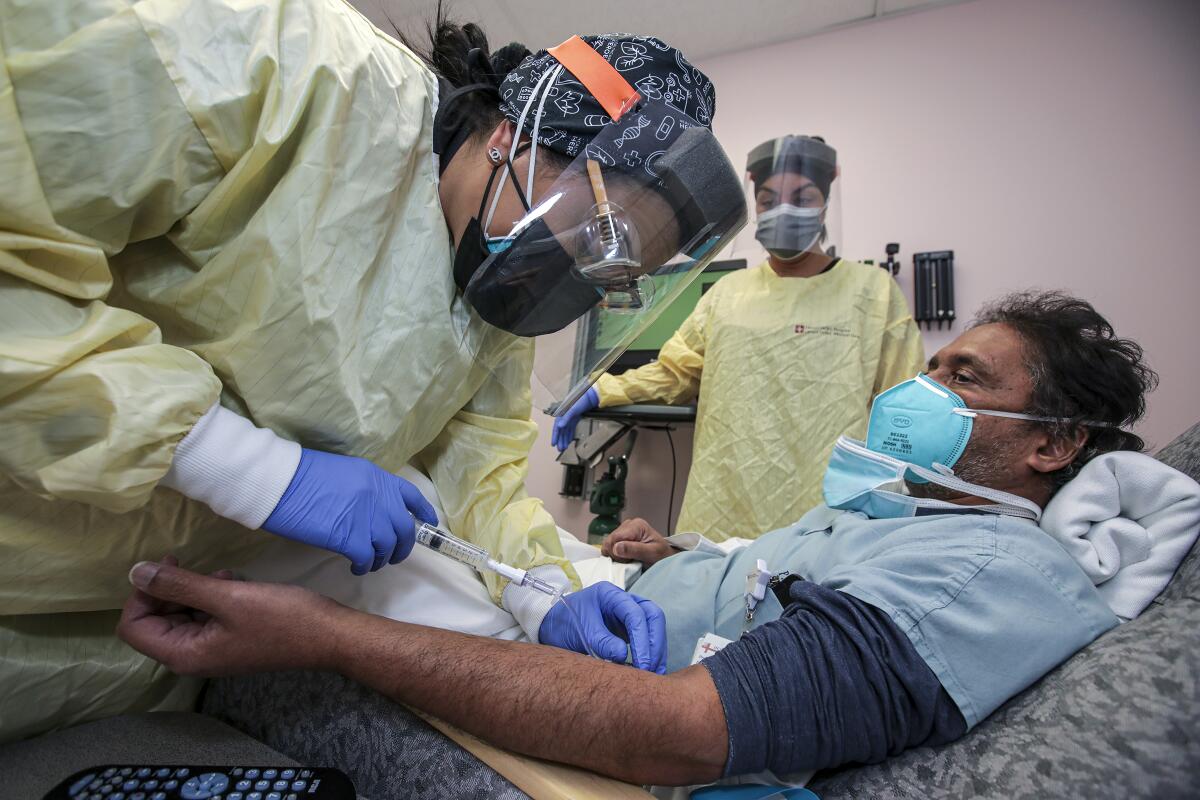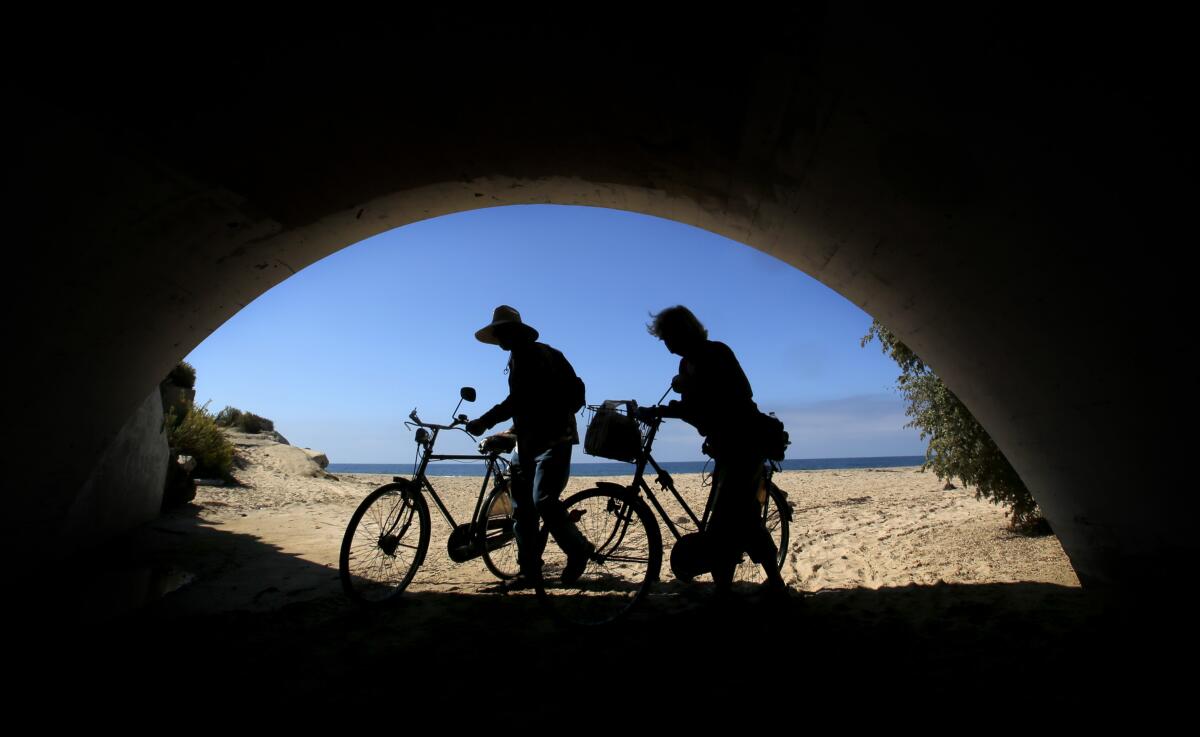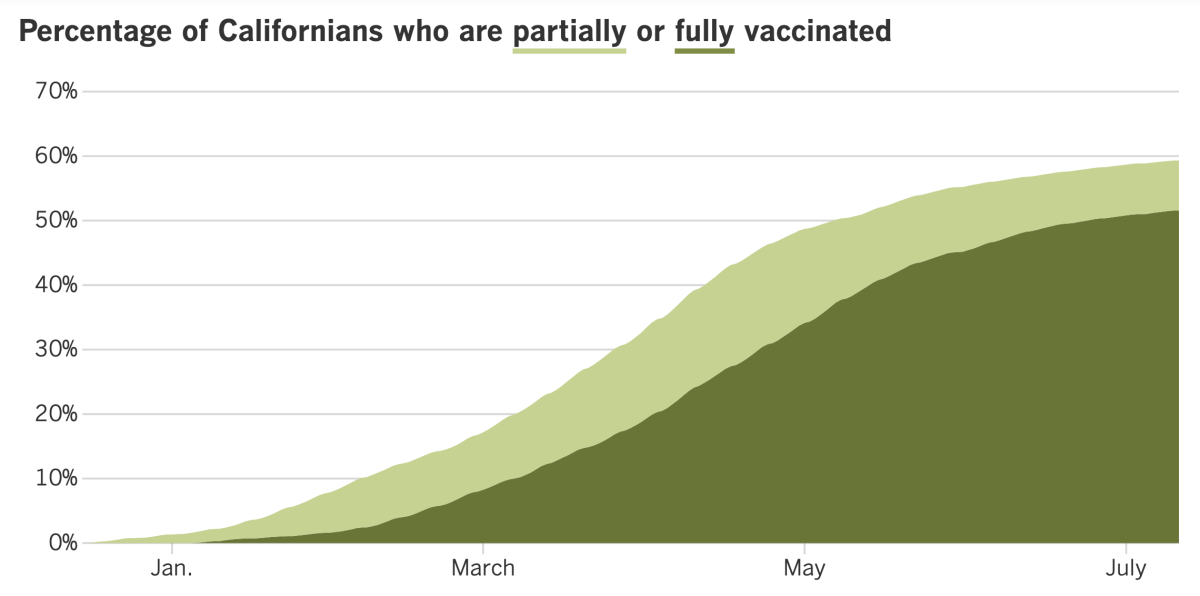Coronavirus Today: Where are the COVID-19 treatments?
- Share via
Good evening. I’m Karen Kaplan, and it’s Tuesday, July 13. Here’s what’s happening with the coronavirus in California and beyond.
For the record:
12:00 a.m. July 16, 2021An earlier version of this newsletter said nearly 3.5 million doses of COVID-19 vaccine had been administered worldwide. The correct figure is nearly 3.5 billion.
COVID-19 vaccines have made it possible for us to return to an almost normal life. With case numbers at levels not seen since March 2020, it’s tempting to think that the threat of serious illness is behind us.
But it’s not. Thousands of new coronavirus infections are being reported in the U.S. each day, and more than 2,500 COVID-19 patients are being admitted to hospitals every day, on average.
It’s too late for vaccines to help these people. What they need is treatments. Which raises an important question that’s often overshadowed by news about the vaccination campaign: Where are the medicines to make people with COVID-19 better?
So far, the Food and Drug Administration has approved only one new drug — the antiviral medication remdesivir — to treat COVID-19. Its modest yet statistically significant benefit in a government-sponsored clinical trial was seen as a pandemic turning point at a time when vaccines were still on the distant horizon.
The FDA has also granted emergency use authorization to several monoclonal antibody treatments. These drugs are designed to work just like the natural antibodies your immune system makes in response to a vaccine or infection. The Regeneron drug that was used to treat former President Trump is in this category.

Unfortunately, that’s where the list of approved and authorized drugs ends. It may strike you as surprisingly short, considering how quickly pharmaceutical companies developed an array of COVID-19 vaccines and got nearly 3.5 billion doses administered worldwide, according to the Johns Hopkins University tracker.
The Biden administration hopes to rectify this by investing $3.2 billion in federal funds to accelerate work on antiviral medicines for people with COVID-19. As my colleague Deborah Netburn explains, “the ultimate goal is to create a pill that could be prescribed immediately after a patient receives a positive coronavirus test result.”
It won’t be easy. As we’ve learned from the Delta variant (and the Alpha variant before it), viruses are adept at mutating, and that means they’re good at finding ways to overcome the medicines we throw at them. A successful drug will have to stage a multi-pronged attack so that the coronavirus doesn’t have much chance to develop resistance.
Juliet Morrison, a microbiologist at UC Riverside, described the attributes of the ideal pill: It would be able to prevent the coronavirus from getting into human cells; it would stop the virus from hijacking the cellular machinery of its human host to make copies of itself; and it would weaken the fortress that protects the virus’ genetic code.
Having a pill like this ready and waiting for newly diagnosed patients is key. That way, the disease could be tamped down before the immune system has a chance to go haywire and cause the kinds of problems that send patients to the hospital.
“We would love to be in a situation like we are with influenza, where patients are diagnosed in a clinic or urgent care and then given a prescription for a pill that they can take at home that will prevent them from getting any sicker,” said Dr. Aneesh Mehta, an infectious diseases specialist at Emory University Hospital.
It sounds like a lot to ask of a single pill, but experts like Mehta believe it can be done in the next six months.
“I am very hopeful,” he told Netburn. “We have some very good candidates.”
By the numbers
California cases, deaths and vaccinations as of 5:15 p.m. Tuesday:

Track California’s coronavirus spread and vaccination efforts — including the latest numbers and how they break down — with our graphics.
How the pandemic ripples across the economy
It stands to reason that an event as life-altering as the COVID-19 pandemic would do a number on the U.S. economy. Now that we’re emerging from the worst of it, the future is coming into focus — and it includes a labor force with fewer baby boomers.
If you’re not a baby boomer yourself, you might assume this has nothing to do with you. You’re still going to work, or planning to once the right job comes along.
But it’s not that simple. The interconnectedness of the economy means we’ll all feel the boomers’ absence in the form of labor shortages, higher wages, and a more fragile Social Security system, among other things.
We’re well-aware that tens of millions of jobs evaporated when the coronavirus forced all kinds of businesses to shut down or scale back their operations. Jobs are returning now, but a surprisingly high number of baby boomers aren’t taking them.
As my colleague Don Lee explains, many older workers who were forced to hunker down at home have decided they’d like to stay there. Even if they have the option of going back, they’ve determined that the money they could earn by clocking in for a few more years simply isn’t worth it.
The pandemic prompted Monique Hanis to reassess her priorities. Now 60, she realizes there are places she’d like to travel with her 68-year-old husband while they’re young enough to enjoy them. Delaying for a few more years to extend her career in strategic communications now looks like an unnecessary risk.
“You can’t always get your healthiest time back,” she said, “and as we get older, that becomes a concern, to be able to physically do the things that we want to do.”

When you add up all the people like Hanis who are coming to the same conclusion, what you’ll find is a significant hole in the labor force. And it’s an important one, since baby boomers have been making up for the worker shortage caused by the Trump administration’s immigration crackdown and the declining number of young Americans entering the job market.
“The fact that boomers were staying in the labor force has been an important contributor to economy-wide growth,” said Richard Fry, a senior researcher at the Pew Research Center.
The consequences of their absence will be felt far and wide, Lee writes:
— Economic growth is likely to slow.
— Overall productivity will take a hit.
— Fewer workers will be contributing to Social Security.
— Income tax revenues will fall, putting pressure on government spending.
— Pensions and retirement savings will be drawn down, influencing the price of all kinds of financial assets.
— Competition for scarce workers will drive up wages, making it more difficult for the Federal Reserve to keep inflation in check.
“We have a more dynamic economy when you have more people in the workforce who are productive and more robust consumers,” said Jeffrey Korzenik, chief investment strategist at Fifth Third Bank in Tampa, Fla. “But there’s no sign they’re coming back.”
California’s vaccination progress


Consider subscribing to the Los Angeles Times
Your support helps us deliver the news that matters most. Become a subscriber.
Around the nation and the world
School’s not even in session, but it still manages to get state health officials tied up in knots.
On Monday, California decreed that K-12 students who were not willing to wear a mask at school would be barred from campus and offered “alternative educational opportunities” instead. (Exceptions would be made for those who had a medical reason to be maskless.)
Just a few hours later, the decree was rescinded. Face coverings are still required, but local school officials will get to decide for themselves how to handle those who refuse to mask up.
The original, short-lived policy was meant to be helpful — a way to provide clarity to educators looking to keep their school environments safe. Now, the status quo from the last school year is back in place.
California is one of only nine states with a mask requirement for schools. An additional eight states prohibit schools from requiring masks, and the vast majority are letting school districts come up with their own policies.
Some parents in Los Angeles are not happy with the mask mandate, telling my colleagues Howard Blume and Melissa Gomez that if thousands of people can crowd into Dodger Stadium without masks, why can’t a few dozen kids in a classroom do the same?
But other parents said universal masking would help keep their children safe — especially those who are too young to be vaccinated. “This is especially true as the Delta variant spreads, and cases start to increase again in Los Angeles,” said Katie Braude, chief executive of the local advocacy group Speak Up.
Braude may be onto something. Summer camps across the U.S. are reporting coronavirus outbreaks — a development that could portend trouble for schools.
A Houston-area church camp that was attended by several hundred young people spawned a two-wave outbreak involving more than 130 kids and adults. “In some cases, entire families are sick,” pastor Bruce Wesley said on the church’s Facebook page.
An outbreak at a Christian youth camp in Illinois spread to 85 teens and adults, including one (unvaccinated) young adult who needed hospital treatment. A church summer camp near Wichita, Kan., was tied to a 50-person outbreak, and health officials in Florida’s Leon County have linked higher coronavirus case numbers with summer camp activity.
Case counts have been rising in L.A. County as well. Officials reported 1,103 new coronavirus cases on Tuesday, the fifth consecutive day the number topped 1,000. Statewide, the average number of daily new cases is topping 2,000 — more than double the figure two weeks ago, according to Times data.
Millions of Californians remain unvaccinated, a fact that makes health officials fear the numbers will get worse. In a telling sign of the power of vaccines, L.A. County Public Health Director Barbara Ferrer said that more than 99% of the people coming down with COVID-19 were unvaccinated. That statistic also applies to Angelenos who die of COVID-19, she said.
L.A. County Supervisor Sheila Kuehl was more pointed in her critique of people who are still unvaccinated. She hopes they “understand the impact that they have, not only on their communities and their families but on other people in their communities” — including healthcare workers, she said. “It just strikes me as enormously selfish.”
In other vaccine news, the FDA has added a new warning to the COVID-19 shot made by Johnson & Johnson, flagging a possible link to Guillain-Barré syndrome. That’s a disorder that can cause muscle weakness and occasionally paralysis.
The Centers for Disease Control and Prevention said it had received reports of 100 people who developed the syndrome after getting the J&J vaccine, but it’s not yet clear whether the shot triggered the illness. One hundred cases may sound like a lot, but it’s tiny compared to the nearly 13 million people who have received the single-dose vaccine.
Men accounted for most of the cases, which typically set in about two weeks after vaccination. Almost all of the patients were hospitalized, and one person died. The CDC’s advisory committee of vaccine experts will examine the evidence linking the two at an upcoming meeting.
Pfizer is talking to U.S. regulators about authorizing a third dose of its vaccine, which the company said would serve as a booster.
The company said early data from an ongoing study suggest that a third dose prompted people’s antibody levels to increase by a factor of five or more. That immunity boost might give people extra power to ward off the Delta variant and other worrisome strains.
But Dr. Anthony Fauci said it’s too soon for the government to recommend a booster.
“Right now, given the data and the information we have, we do not need to give people a third shot,” he said. However, he acknowledged that down the line, “it is entirely conceivable, maybe likely” that a booster will be necessary.
The head of the World Health Organization is not happy with Pfizer for trying to sell third doses to the U.S. when so many people around the world are still waiting for their first dose.
Tedros Adhanom Ghebreyesus called on Pfizer and Moderna to “go all out to supply COVAX, the Africa Vaccine Acquisition Task Team and low and middle income countries with very little coverage.” The massive disparity between rich and poor countries means that “we are making conscious choices right now not to protect those in need,” he said.
Both Pfizer and Moderna have agreed to send small amounts of their vaccine to COVAX, an initiative of the United Nations. However, the vast majority of their doses have been reserved by wealthy countries.
Your questions answered
Today’s question comes from readers who want to know: Are COVID-19 symptoms worse for people infected with the Delta variant?
As far as doctors and scientists can tell, the answer is no.
There do seem to be some mild differences in symptoms — for instance, the Delta variant is more likely than other versions of the coronavirus to cause a runny nose, according to Dr. Otto Yang, an infectious disease expert at UCLA.
“There are mild differences like that, but overall it’s very, very similar,” he told my colleague Amina Khan. Cough, shortness of breath and fever are still “the most important symptoms,” he said.
It’s hard to tell whether the Delta variant causes more serious disease because with COVID-19, “the natural degree of severity is so widely variable — it ranges from completely asymptomatic to severe illness and death,” Otto added.
Dr. Robert Bollinger, an infectious disease expert at Johns Hopkins University, seconded that view: “I think the jury’s still out on that.”
The Delta variant may seem more dangerous because the people it’s infecting are younger than in the past. But that’s not necessarily due to the virus, Bollinger told Khan. The more likely explanation is that the COVID-19 vaccination rate is higher for older people, leaving a greater proportion of younger adults vulnerable.
Reports of so-called breakthrough infections are starting to emerge with the Delta variant, but there’s no reason to think they’re more likely to occur.
“We haven’t seen evidence of that just yet,” Bollinger said.
We want to hear from you. Email us your coronavirus questions, and we’ll do our best to answer them. Wondering if your question’s already been answered? Check out our archive here.
Resources
Need a vaccine? Sign up for email updates, and make an appointment where you live: City of Los Angeles | Los Angeles County | Kern County | Orange County | Riverside County | San Bernardino County | San Diego County | San Luis Obispo County | Santa Barbara County | Ventura County
Need more vaccine help? Talk to your healthcare provider. Call the state’s COVID-19 hotline at (833) 422-4255. And consult our county-by-county guides to getting vaccinated.
Practice social distancing using these tips, and wear a mask or two.
Watch for symptoms such as fever, cough, shortness of breath, chills, shaking with chills, muscle pain, headache, sore throat and loss of taste or smell. Here’s what to look for and when.
Need to get tested? Here’s where you can in L.A. County and around California.
Americans are hurting in many ways. We have advice for helping kids cope, resources for people experiencing domestic abuse and a newsletter to help you make ends meet.
We’ve answered hundreds of readers’ questions. Explore them in our archive here.
For our most up-to-date coverage, visit our homepage and our Health section, get our breaking news alerts, and follow us on Twitter and Instagram.




